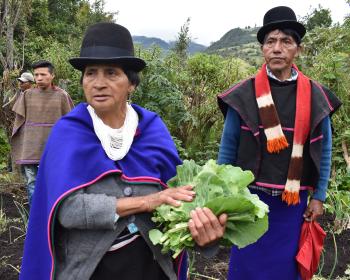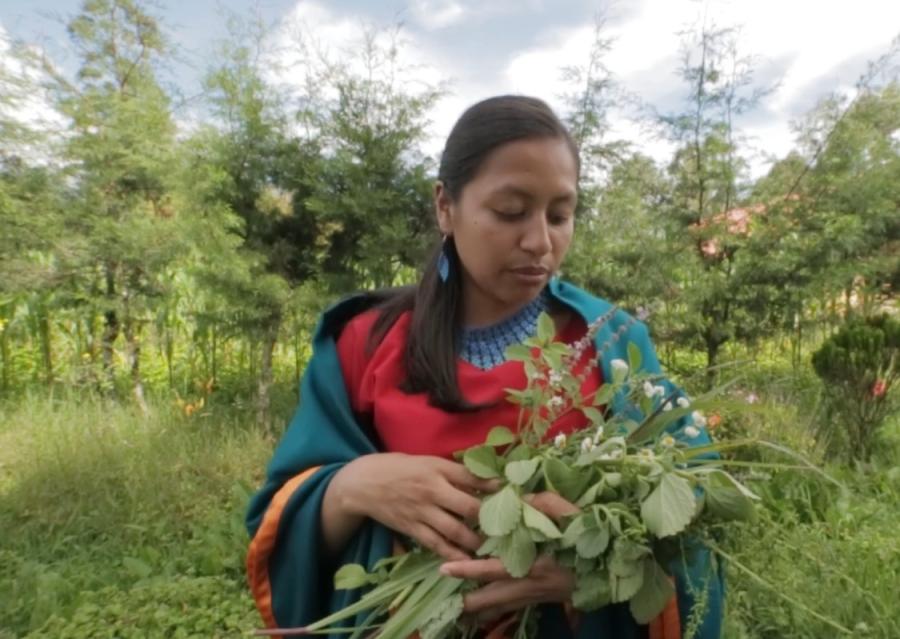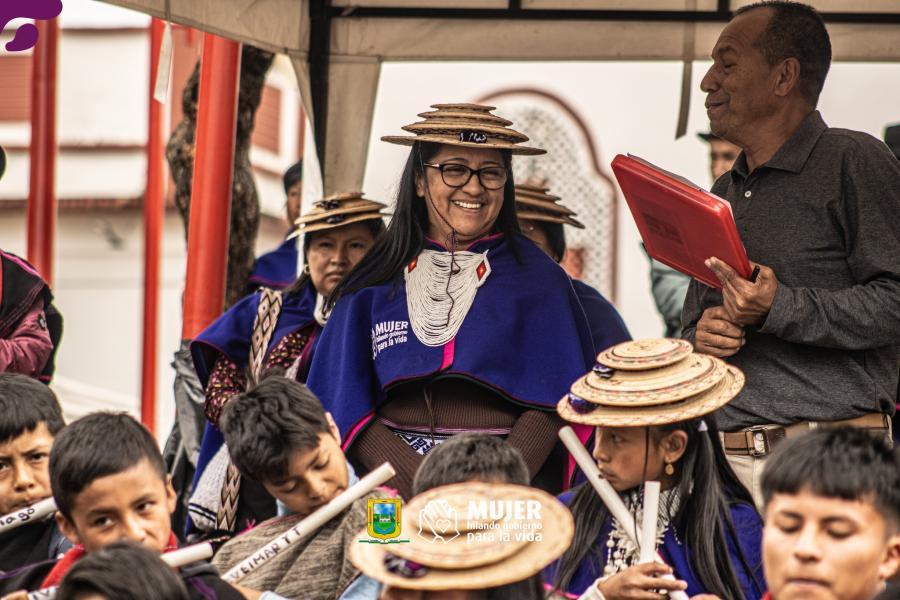Modernity, Ethnicity and Development from the `Outside'
Indigenous peoples are consistently the objects of development politics. Development policies directed at Indigenous societies all too frequently stress the importance of the peoples giving up their culture in order to `develop' and not stand in the way of national modernization efforts. Implicit in such a notion of development is the idea that ethnicity and modernity cannot be intertwined.
Nowadays, however it is widely accepted that indeed they can be. Even entities like the World Bank have Indigenous development plans that not only acknowledge the right of Indigenous societies to their own culture, but also even stress the importance of their participation in the development efforts. Ethnicity is no longer viewed as an obstacle.
However, the notion persists that development comes from the `outside.' Indigenous peoples might be consulted on what is to be achieved, they might even be part of the planning, but the initiative for action is left to the world outside their communities.
The Constitution of 1991 and Plan de Vida
This notion of development is now being seriously challenged by a new Indigenous development initiative that a number of Indigenous communities in Colombia have initiated, called Plan de Vida (Plan of Life).
The fiscal and organizational framework for Plan de Vida was provided by the new Political Constitution of Colombia of 1991, which enacted a number of laws recognizing and protecting Indigenous rights, and granting Indigenous communities a considerable degree of autonomy. In respect to development, Law 60 of the new Constitution is designed to provide communities with more financial resources at the local level. Law 152, which is concerned with the institutionalization of the national development planning, states that the cabildos, the governing bodies of the Indigenous communities, are free to plan in line with their own development priorities. The cabildos may conduct their planning in ways that are `in accordance with their cultural and social systems' (IACHR 1999:287). With the yearly funding that cabildos receive from the national government, this Indigenous people are able to design independent complex long-term development plans - Planes de Vida.
The new constitution incorporates principles such as:
- The right to an identity as an Indigenous people, which involves the right to be different, and to be free from discrimination in relations with the State and society.
- The right to sufficient territory to reproduce culturally as a people.
- The right to autonomy in the various spheres of life as a people, i.e. government, justice, education, health, social and economic reproduction, etc., in order to regulate ethnic reproduction and cultural changes.
- The right to participation in the various spheres of national life and the right to prior consultation on the measures, plans, programs, and projects that may affect their ethnic identity, their territories, or the natural resources situated therein.
- The right to development, in the sense of future development of their social groups, their culture, and improvement of their own quality of life, in accordance with their cultural and social systems and the life plans they devise or carry out as peoples, and their own development in terms of their intercultural relationship with national development. (IACHR 1999:287)
The Guambiano Plan of Life
The concept of a `plan of life' was first perceived by the Guambiano, an Indigenous group living in the Cauca region of Colombia. They had already started to work on a long-term plan as far back as 1987, four years before the new constitution came into effect, due in part to dissatisfaction within the community with the existing organizational work of their cabildos. They finished their Plan de Vida in 1994.
For the Guambiano, Plan de Vida, as a term, suggests more than just a plan for economic and social development. Its central motive is not an adaptation to the Western world, but the preservation and recuperation of Guambiano life. As a result, a large part of the plan is dedicated to Guambiano history and culture. Through historical analysis, the creators of the plan reveal the reasons for the problems of contemporary Guambiano society, tracing most of them back to the `development' that occurred during the last few decades, which has resulted in an increasing gap between the rich and the poor, divisions within the community, and the demise of social structures. The societal problems are considered to be a result of the negative influences from the outside world. Accordingly, the plan is very anti-modernization in nature. (Gow 1997:253-257) However, the Guambiano leaders are aware that in today's increasingly interconnected and challenging world their community cannot revert to the lifestyles of their ancestors. The Guambiano, like many Indigenous peoples, have negotiated radical changes within a short amount of time. They realize a need to adapt to these new circumstances - but on their own terms.
As a consequence, their plan includes those commonplace aspects of standard development plans, such as health, education, economics, etc. - though cultural aspects predominate. The Guambianos realize the need for certain adaptations to be made to their way of life in order to be able to survive in the modern world, but those adaptations are the means to survive and keep the integrity of their culture. Through Plan de Vida, they want to retain their culture, and even revive what has been lost in the past.
As Guambiano representative Alvaro Morales says, "The future is behind us." The plan is designed to serve the future needs of the community as it pursues a path towards what is yet to come, but the standards by which the success of this project is measured are the values of the Guambiano elders. The future that they are designing will be in accordance with their elder's knowledge of the past. It will recuperate the past.
In a number of ways Plan de Vida works towards achieving such a cultural revival, for example, by implementing education programs - teaching the knowledge of their elders and focusing on the Guambiano cultural heritage. But Plan de Vida encompasses much more. It also suggests solutions to more pressing problems such as the severe impact of the growing of illicit crops, in particular opium poppies, by some of their farmers, due to their shortage of arable land. This has brought considerable problems to the community, the most significant of which being violence by the many different groups involved in the drug war, such as competing cartels, guerrilla groups, and government forces. Their Plan de Vida addresses this issue by promoting alternative modes of production. The Guambianos have started, for instance, in collaboration with the UN, to commercialize trout selling, and are now producing 4-5 tons of trout per month. Yet another aspect is an outreach program designed to consolidate their relations with neighboring Indigenous communities, because "we share the same environment" (ibid.). In November 1999, representatives of all the communities within their municipality met to discuss and find solutions to the problems they face.
The following chart depicts all the different facets of the Plan de Vida del Pueblo Guambiano, which is divided into three parts, economic, social/cultural, and networking.
The Guambianos, however, are worried that some outsiders still do not give Plan de Vida its due. They do not realize that this remarkable concept aspires to traditional ideals, while simultaneously being both pragmatic and realistic.
Of course, Plan de Vida is still dependent upon government funding. Yet, for the first time, the Indigenous peoples have relative autonomy in the way they allocate their funds. In the past, it was usually outside forces that controlled which aspects of a culture were to be protected, and which were not, by controlling this funding. In Australia for example, world-famous Aboriginal art is protected and promoted by the government, but the territory is not granted them upon which to practice their art in a cultural context. In Colombia, for the first time, Indigenous peoples have the legal framework to choose their own pathways.
The Case of the Embera
Since the new constitution came in effect, many peoples in Colombia, particularly in the Cauca region, have followed in the footsteps of the Guambianos and created their own Planes de Vida, such as the Embera, the Paez, the Yanacon, and many others.
In an interview with Paulo Valencia, a representative of the Embera, he states that though his community plan reflects the particular needs of his group, it shares some of the same themes the Guambiano Plan expresses, such as the usual social, economic and environmental aspects, while also keeping a strong focus on cultural recuperation.
"Part of the plan is to revive how our ancestors lived, because the Plan of Life is not just a development proposal, but also a plan for the life of the Embera people." Mr. Valencia states that "We not only seek a transformation in the world. With our Plan de Vida we look for a transformation of the Embera person. The plan seeks to improve the lives of the individuals in relation to their group, not just to improve the group's relation to the global arena."
Although different communities might place different emphasis on either ethnicity or modernity, depending on their situation, the general idea of Plan de Vida as a means of reviving one's culture while at the same time adapting to the problems of today, remains the same.
The Colombian Picture
The Indigenous peoples of Colombia are involved in serious struggles. The U'wa have for years been struggling against the oil company Occidental, who has recently succeeded in gaining the Colombian national government's permission to construct test wells for oil on traditional U'wa territory.
The Embera Katio are opposing a massive hydroelectric dam project, placing them between the lines of guerrillas, militias, paramilitaries, and government forces, each trying to enforce their particular interests. Many other groups face similar problems.
Although the Colombian government has established a unique framework that allows Indigenous peoples to create their own development plans, one ought not to forget that the government, largely dependent upon the finances generated by international corporate interests, is not in a position to accede to Indigenous notions if they conflict with largescale national interests, or development efforts. When a major project is endangered due to the initiative of Indigenous peoples, the government is more likely to suppress its opponents than to give in to the interests of the people. As of now, Colombia is still embroiled in civil war, and the Indigenous communities are all too often the ones caught in the line of fire. However, even facing problems such as these, Plan de Vida can provide Indigenous peoples with a perspective, a program, on how to proceed, as difficult as that may be.
Conclusion
As far as Indigenous initiatives are concerned, Plan de Vida is quite extraordinary. Rarely have Indigenous groups linked ethnicity and modernity in such a way, and few have the necessary legal and fiscal framework to create such refined plans. Plan de Vida is a development concept, but not in the Western sense - it does not aspire to Western values. It is a development plan only insofar as these communities have realized that they need to incorporate long term changes in order to be able to survive in this world. They are `developing' new ideas for dealing with today's problems - which are different from the ones in the past, and in many respects `far more radical' (Paulo Valencia pers com 1999). Their development plans are an initiative for survival in today's global economy. But the survival they seek is a cultural survival. The practical steps they are taking, the adaptations that they make, are designed in hopes of salvaging the integrity of their culture and recuperating what they have lost along the way. An independent Indigenous concept such as this is also what the Cambridge-based NGO Cultural Survival is trying to promote: Leaving it up to the people to decide where they want to go, and it is up to us, as advocates of the Indigenous cause, to support them on their chosen path. Plan de Vida is a path well worth emulating and supporting.
References:
Cabildo, Taitas, Comision de Trabajo del Pueblo Guambiano (1994). Plan de Vida del Pueblo Guambiano. Territorio Guambiano-Silvia: Cabildo del Pueblo Guambiano.
Gow, David (1997). Can the Subaltern Plan? Ethnicity and Development in Cauca, Colombia. In: Urban Anthropology. 26 (3-4), pp. 243-292.
IACHR (Inter-American Commission on Human Rights of the Organization of American States) (1999). Third Report on the Human Rights Situation in Colombia.
OEA/Ser.L/V/II.102. Washington, D.C.
Maybury-Lewis, David (1985). A Special Sort of Pleading - Anthropology at the Service of Ethnic Groups. In: Advocacy and Anthropology, First Encounters. Robert Paine (ed.). St John's Institute of Social and Economic Research of the Memorial University of Newfoundland, pp. 130-148.
Pigg, Stacey Leigh (1997). Found in Most Traditional Societies: Traditional Medical Practitioners between Culture and Development. In: International Development and the Social Sciences: Essays on the History and Politics of Knowledge. Frederick Cooper/Randall Packard (eds.). Berkeley: University of California Press, pp. 259-290.
Footnotes:
1. The Constitution also ratifies and incorporates into domestic law ILO Convention 169.
In relation to this, the author contacted a number of oil companies (Occidental, Arco, Chevron, BP-Amoco) that are involved in projects in Colombia or other parts of South America to ask them for information on Plan de Vida. Interestingly, none of them knew anything about it, which is quite startling, considering how much of their PR-efforts are focused on how much they know and care about the communities they are working with, and how much they are up to date with the indigenous world.
2. More than 500 Indigenous leaders were assassinated for political reasons within the last 25 years, partly by State security forces or State-related groups. (IACHR 1999:292)
Article copyright Cultural Survival, Inc.



